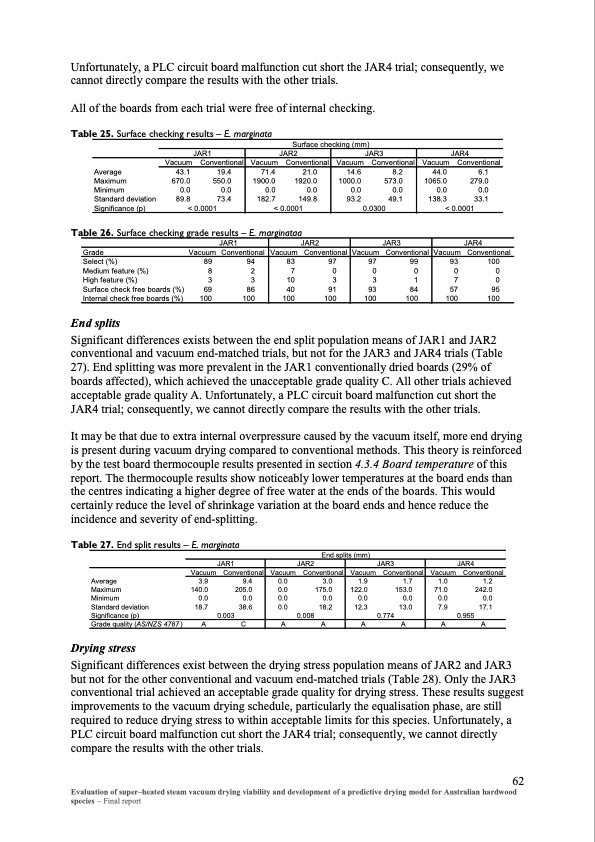
PDF Publication Title:
Text from PDF Page: 069
Unfortunately, a PLC circuit board malfunction cut short the JAR4 trial; consequently, we cannot directly compare the results with the other trials. All of the boards from each trial were free of internal checking. Table 25. Surface checking results – E. marginata Surface checking (mm) JAR2 JAR3 Vacuum Conventional Vacuum Conventional 71.4 21.0 1900.0 1920.0 0.0 0.0 182.7 149.8 < 0.0001 14.6 8.2 1000.0 573.0 0.0 93.2 0.0300 0.0 49.1 Average Maximum Minimum Standard deviation Significance (p) JAR1 Vacuum Conventional JAR4 Vacuum Conventional 44.0 6.1 1065.0 279.0 0.0 0.0 138.3 33.1 < 0.0001 JAR4 Vacuum Conventional 93 100 0 0 7 0 57 95 100 100 43.1 670.0 0.0 89.8 19.4 550.0 0.0 73.4 Table 26. Surface checking grade results – E. marginataa < 0.0001 JAR2 JAR3 Vacuum Conventional Vacuum Conventional 83 97 70 10 3 40 91 100 100 97 99 00 31 93 84 100 100 Grade Select (%) Medium feature (%) High feature (%) Surface check free boards (%) Internal check free boards (%) End splits JAR1 Vacuum Conventional 89 8 3 69 100 94 2 3 86 100 Significant differences exists between the end split population means of JAR1 and JAR2 conventional and vacuum end-matched trials, but not for the JAR3 and JAR4 trials (Table 27). End splitting was more prevalent in the JAR1 conventionally dried boards (29% of boards affected), which achieved the unacceptable grade quality C. All other trials achieved acceptable grade quality A. Unfortunately, a PLC circuit board malfunction cut short the JAR4 trial; consequently, we cannot directly compare the results with the other trials. It may be that due to extra internal overpressure caused by the vacuum itself, more end drying is present during vacuum drying compared to conventional methods. This theory is reinforced by the test board thermocouple results presented in section 4.3.4 Board temperature of this report. The thermocouple results show noticeably lower temperatures at the board ends than the centres indicating a higher degree of free water at the ends of the boards. This would certainly reduce the level of shrinkage variation at the board ends and hence reduce the incidence and severity of end-splitting. Table 27. End split results – E. marginata JAR1 Vacuum Conventional End splits (mm) JAR4 Vacuum Conventional JAR2 JAR3 Vacuum Conventional Vacuum Conventional 0.0 0.0 0.0 0.0 0.008 3.0 175.0 0.0 18.2 1.9 122.0 0.0 12.3 0.774 1.7 153.0 0.0 13.0 AA AA Average Maximum 140.0 Minimum 0.0 Standard deviation 18.7 Significance (p) Grade quality (AS/NZS 4787 ) A Drying stress 3.9 9.4 205.0 0.0 38.6 C 1.0 71.0 0.0 7.9 A 1.2 242.0 0.0 17.1 A 0.003 0.955 Significant differences exist between the drying stress population means of JAR2 and JAR3 but not for the other conventional and vacuum end-matched trials (Table 28). Only the JAR3 conventional trial achieved an acceptable grade quality for drying stress. These results suggest improvements to the vacuum drying schedule, particularly the equalisation phase, are still required to reduce drying stress to within acceptable limits for this species. Unfortunately, a PLC circuit board malfunction cut short the JAR4 trial; consequently, we cannot directly compare the results with the other trials. 62 Evaluation of super–heated steam vacuum drying viability and development of a predictive drying model for Australian hardwood species – Final reportPDF Image | Evaluation of super-heated steam vacuum drying

PDF Search Title:
Evaluation of super-heated steam vacuum dryingOriginal File Name Searched:
PN08_2047_Vacuum_Drying_Reviewed_Report.pdfDIY PDF Search: Google It | Yahoo | Bing
5,000 BF Shipping Container Lumber Dry Kiln For Quality Lumber The 5,000 BF container kiln consists of one 40 foot high-cube aluminum shipping container... More Info
Shipping Container Lumber Dry Kilns by Global Energy Global Energy designed and developed the container kiln back in 1991. The purpose is to give access to portable sawmill owners, furniture makers, and small business the value added profit of dry kiln lumber and quality hardwoods... More Info
Vacuum Kiln Conversion Kit for Lumber and Wood Dry Kilns Convert your existing conventional dry kiln into a fast drying vacuum kiln. Similar to vacuum bagging in the boat building and aircraft industry, we have come up with a proprietary process which allows you to build a very simple vacuum kiln at a fraction of the price, and without the intensive conventional metal chamber structure... More Info
Vacuum Pump Cart System for Bagging Clamping Wood Drying and more Vacuum Cart with 2HP Pump and Dual Pistons with multiple multiplex vacuum ports and liquid reservoir... More Info
Vacuum Bagging Basics Vacuum bagging is a method of clamping, which has traditionally been used in the composites industry, but can also be used for vacuum drying materials, including wood products... More Info
| CONTACT TEL: 608-238-6001 Email: greg@globalmicroturbine.com | RSS | AMP |